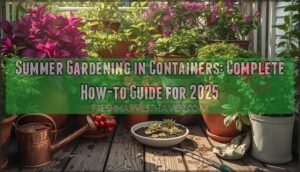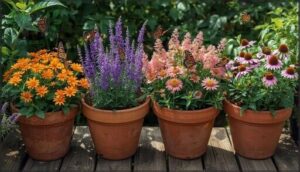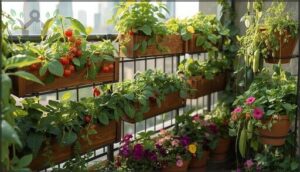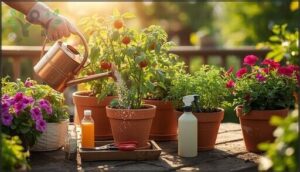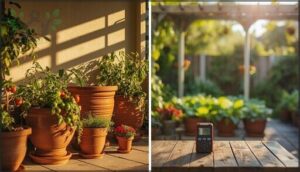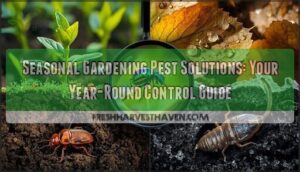This site is supported by our readers. We may earn a commission, at no cost to you, if you purchase through links.
Container gardens transform tight spaces into productive summer oases, but success hinges on choices you make before planting your first seed. A terracotta pot might crack after three winters, while a concrete container can outlast your mortgage.
The difference between wilted petunias in July and blooms that last seventeen weeks straight comes down to matching your plants to their environment and understanding what thrives when temperatures climb.
Summer gardening in containers demands more than tossing soil into a pot and hoping for the best. You need the right materials, heat-tolerant plants, and maintenance strategies that work with the season’s intensity rather than against it.
Get these fundamentals right, and you’ll grow everything from 300-flower calibrachoa to cherry tomatoes producing 100 fruits per plant—all without a single square foot of ground soil.
Table Of Contents
- Key Takeaways
- Essential Containers for Summer Gardening
- Selecting Heat-Tolerant Container Plants
- Creative Container Garden Design Ideas
- Summer Care and Maintenance Tips
- Optimizing Sunlight and Placement
- Troubleshooting Common Summer Challenges
- Frequently Asked Questions (FAQs)
- What plants like full sun and heat in pots?
- What is the most common mistake made with container plants?
- What flowers bloom all summer in pots?
- What are the best vegetables for container gardening?
- What are the best plants for summer pots outdoor?
- What are two disadvantages of container gardening?
- How do I prevent pests in container gardens?
- What vegetables grow best in containers?
- How to improve drainage in container planters?
- Can I reuse potting soil every summer?
- Conclusion
Key Takeaways
- Container material choices directly impact plant survival—concrete lasts 30-50 years and handles heat best, while terracotta cracks after 3-5 years and dries out 15% faster than plastic alternatives.
- Heat-tolerant plants like zinnias, calibrachoa, and cherry tomatoes can produce 225+ cultivars, 300+ flowers per season, or 100 fruits per plant when matched with proper container sizes (5-gallon minimum for tomatoes, 2-gallon for greens).
- Daily soil moisture checks and twice-daily watering during extreme heat prevent the number one killer of container gardens—overwatering causes root suffocation while underwatering triggers heat stress above 104°F root temperatures.
- Strategic placement in partial shade, using 2-3 inches of mulch, and rotating containers quarterly cuts lopsided growth by 60% while reducing watering needs by 40% compared to full-sun exposure.
Essential Containers for Summer Gardening
Your container choice sets the stage for everything that comes next. The right pot protects roots from summer heat, prevents waterlogging, and keeps plants thriving when temperatures climb.
Let’s look at the key factors that’ll help you pick containers built for hot-weather success.
Material Types and Durability
Your choice of pot material directly affects how long your containers will last and how much care they’ll need. Each option brings different strengths to your summer garden. Concrete pots, known for their vegetable growing suitability, are also resistant to rot and rust.
- Terracotta lifespan averages 3–5 years before freeze-thaw cycles cause cracks, though these porous ceramic pots dry out 15% faster than plastic
- Plastic pots degrade after 2–5 years in sunlight unless you choose UV-resistant resin types that hold up 75% longer
- Wood rot sets in within 2 years for untreated planters, but pressure-treated or rot-resistant varieties last 7–10 years
- Metal corrosion varies widely—thin sheets fail in 2–4 years while galvanized versions can reach 15–30 years
- Concrete longevity wins hands-down at 30–50 years, though fabric pots offer lightweight portability for annual use
Choosing The Right Size and Shape
Bigger isn’t always better when matching containers to plant needs. Root space determines success—tomatoes and peppers need five-gallon pots with 12–18 inch depth, while lettuce thrives in two gallons. Here’s how container size affects your summer garden:
| Plant Type | Minimum Volume | Depth Needed |
|---|---|---|
| Tomatoes, peppers | 5 gallons | 12–18 inches |
| Lettuce, greens | 2 gallons | 4–6 inches |
| Herbs, radishes | 1 gallon | 4 inches |
| Beets, carrots | 3 gallons | 8 inches |
Rectangular containers allow for planting in rows, whereas cylindrical pots offer better wind resistance. Wider bases can hold more soil, which reduces watering frequency by 40% during heat waves. Smaller pots are less expensive initially but require daily attention—balance your budget against the time needed for maintenance. Remember that proper spacing prevents fungal diseases.
Best Drainage Solutions for Hot Weather
Matching container size to roots doesn’t matter if drainage fails during heat waves. You’ll prevent most water-related failures with these four essentials:
- Drill drainage holes at least 0.5 inches wide—two minimum, increasing to 4-6 for larger planters
- Layer substrates like 60mm coarse sand at the bottom to speed drying
- Amend soil with 25% perlite to cut waterlogging risk by 40%
- Apply mulch on top to reduce evaporation by 35%
Terracotta breathes better than plastic but dries faster—choose based on your watering schedule.
Selecting Heat-Tolerant Container Plants
Summer heat can be brutal on container gardens, but choosing the right plants makes all the difference. You need varieties that can handle intense sun, high temperatures, and occasional dry spells without losing their beauty.
Let’s look at three categories of heat-tolerant plants that’ll thrive in your containers all season long.
Sun-Loving Blooms and Succulents
When you want blooms that thrive under relentless summer heat, zinnias lead the pack—over 225 cultivars deliver nonstop color across zones 3-9. Calibrachoa produces 300+ flowers per season, while petunias bloom for 17 weeks straight in full sun.
For succulents, echeveria and hens-and-chicks tolerate root zone temps above 100°F. These drought-resistant plants need 6-8 hours of direct sunlight daily for peak performance.
Drought-Resistant Foliage and Grasses
For containers that beat the heat, ornamental grasses and drought-resistant plants deliver unparalleled seasonal performance. Blue fescue and maiden grass (container-hardy to Zone 6) thrive with under 1 inch of weekly water.
Creeping juniper survives down to Zone 5, displaying copper-toned foliage visual impact each fall.
These water-wise choices can slash your irrigation needs by 60% compared to traditional container gardening.
Compact Edibles and Herbs for Pots
Cherry tomatoes yield up to 100 fruits per plant in 3-gallon pots, while Quick Snack cucumber produces dozens of 3-inch fruits on plants under 2 feet tall. For herbs, basil generates 50 leaves per season in 6-inch containers, and chives regrow after clipping.
Succession planting of compact edible plants provides three harvests per container from May through October, greatly extending your summer container gardens’ productivity.
Creative Container Garden Design Ideas
The real fun in container gardening starts when you get creative with what goes into each pot. You can combine ornamental flowers with fresh herbs and veggies, build vertical gardens that save space, or create pollinator havens that bring butterflies and bees right to your doorstep.
Here are three design approaches that’ll help you make the most of your container gardens this summer.
Mixing Flowers, Foliage, and Edibles
Think of your container gardens as a summer buffet—beautiful and delicious. Over half of gardeners now blend edible plants with ornamental foliage and flowers for dual-purpose displays. This design strategy delivers measurable yields while keeping your pots stunning.
- Swiss chard adds colorful stems alongside fresh greens throughout summer
- Trailing tomatoes provide both visual impact and 35–60 fruits per plant
- Edible flower integration through nasturtium or calendula creates continuous blooms
- Leafy herbs like basil or purple sage offer texture, harvest, and fragrance
Match sun and water needs for best results.
Pollinator and Butterfly-Friendly Arrangements
You can double your butterfly sightings by choosing native species that offer rich floral resources all summer long. Pollinator paradise planters work best when you group at least four bloom types—like lantana, salvia, and milkweed—in containers placed within a meter of each other. This structural design boosts visits by 41%.
Simple maintenance practices like deadheading spent flowers extend peak performance and keep butterfly-attracting gardens thriving.
Space-Saving Vertical and Tiered Setups
Going up instead of out transforms tight balconies into productive green spaces. Vertical yield jumps seven to twenty times per square foot, while tiered diversity lets you mix five plant types in one footprint. Urban adoption is skyrocketing—searches for vertical container garden ideas exceed 14,800 monthly in India alone.
These space-saving setups deliver microclimate effects too:
- Lower ambient temperatures by up to 5°C
- Filter 85% of airborne dust and pollutants
- Support twelve to fifteen plants per square meter
- Reduce indoor heat gain by 23–38%
Summer Care and Maintenance Tips
Your summer containers won’t thrive on their own—they need consistent attention to stay healthy and productive through the heat. The right care routine makes the difference between wilting plants and vibrant displays that last all season.
Here’s what you need to focus on to keep your container garden performing at its peak.
Watering Techniques and Schedules
Your watering schedule determines summer success. Check soil moisture daily—water when the top 1–2 inches feel dry. Small containers often need watering twice daily in extreme heat, while larger pots may require it only once. Early morning or early evening watering techniques reduce evaporation by 30%.
Container material impacts watering frequency: porous fabric dries faster than plastic. Mulching benefits include cooler roots and less water loss, preventing stress during peak summer heat.
Fertilizing for Healthy Growth
Proper nutrition keeps your containers thriving. Begin fertilizing container gardens two to six weeks after planting—annuals and edibles need water-soluble fertilizer every two weeks during summer. Choose products with balanced nutrient ratios like 20-20-20, which closely match plant needs. Application timing matters: feed during peak growth and skip occasional waterings to flush excess salts. CRF guidelines suggest six-month formulations for long-season bloomers. Deficiency prevention includes calcium and magnesium supplements, especially important in soilless mixes.
Here’s your summer gardening tips checklist:
- Water-soluble feeds: Apply diluted every 2–3 weeks
- Controlled-release options: Use 10–15 pounds per cubic yard
- pH maintenance: Add acidifying fertilizer for iron uptake
- Environmental impact: Avoid overfeeding to reduce runoff
Fertilizing smart means healthier plants and less waste.
Deadheading, Pruning, and Refreshing Plants
Beyond feeding, summer gardening tips include regular grooming to heighten your bloom duration. Deadheading offers significant benefits—removing spent flowers can increase bloom count by up to 40% over a 12-week season. Pruning techniques improve air circulation, reducing fungal disease by 60% during humid months. These rejuvenation practices keep containers looking spruced up all summer.
| Task | Method | Benefit |
|---|---|---|
| Deadheading | Snip faded blooms at leaf nodes | Extends blooming 2–4 weeks |
| Pruning leggy growth | Trim back overgrown stems | Creates bushier plants |
| Removing damaged foliage | Cut diseased leaves weekly | Reduces pests by 44% |
| Container refreshing | Replace top 2 inches of soil | Improves mid-season vitality |
| Thinning crowded plants | Remove weak or competing stems | Increases light penetration 25% |
Container garden care means regular maintenance pays off with healthier, more productive displays.
Optimizing Sunlight and Placement
Getting the light right can make or break your container garden during summer’s peak heat. Most plants need at least six hours of direct sun, but some varieties perform better with afternoon shade to prevent scorching.
Let’s look at how to position your containers for the strongest, healthiest growth all season long.
Finding The Ideal Location
Where should you place your containers to set them up for success? Sunlight exposure is just the starting point—balcony load limits, wind exposure, reflective heat, orientation effects, and microclimate factors all shape your growing environment. Smart placement harnesses these elements instead of fighting them.
- Southern and western orientations deliver intense sun and heat, while eastern exposures offer gentler morning light
- Reflective surfaces like glass and concrete can concentrate heat, accelerating moisture loss and stressing plants
- Adequate spacing between containers improves airflow and keeps humidity from building up around foliage
Managing Full Sun Vs. Partial Shade
Once you’ve found a good spot, matching your plant selections to actual sunlight exposure separates success from struggle. Full sun means six or more hours of direct light, while partial shade offers two to four hours or dappled coverage. Leafy greens thrive with less, but fruiting crops like tomatoes need that full intensity—yields drop up to 40% below the six-hour mark.
| Light Level | Best Plant Types |
|---|---|
| Full sun (6+ hours) | Tomatoes, peppers, succulents, Mediterranean herbs |
| Partial sun (4-6 hours) | Root vegetables, many annuals, heat-tolerant herbs |
| Partial shade (2-4 hours) | Leafy greens, parsley, kale, shade-thriving ferns |
| Full shade (1-3 hours) | Woodland species, low-light tolerant ornamentals |
| Dappled light | Mixed greens, chives, impatiens, begonias |
Shaded containers need watering less often—sometimes 40% less than full sun placements—but plant positioning matters just as much as plant choice. Microclimates shift throughout your space, and airflow prevents heat stress even in bright spots.
Moving and Rotating Containers
By rotating your containers a quarter turn at each watering, you’ll cut lopsided growth by over 60%. Rolling plant caddies make this routine simple while reducing heat stress during summer gardening.
Rotate containers a quarter turn each watering to cut lopsided growth by 60% and reduce heat stress
Every two to three months works for bright spots; shade-dwellers need movement every few weeks.
This simple plant care habit boosts yields, improves airflow, and prevents fungal outbreaks—smart space management that keeps containers thriving.
Troubleshooting Common Summer Challenges
Even the best container gardens hit a few bumps during the hot months. You’ll face wilting plants, unwanted pests, and stems that stretch too far looking for light.
Here’s how to spot these issues early and bring your containers back to health.
Preventing Heat Stress and Wilting
Heat stress hits when root-zone temperatures climb past 104°F, sometimes spiking above 120°F on west-facing container walls. You can lower the risk with these strategies:
- Container placement in partial shade cuts root temperatures by 15°F
- Mulching techniques using 2–3 inches of organic material reduce evaporation 10–15%
- Watering frequency increases to twice daily during extreme heat
- Shade solutions like green cloth improve water use efficiency
- Reflective containers (white, not dark) minimize absorbed heat
Check soil moisture daily—wilting isn’t always thirst.
Pest and Disease Management
Container pests—aphids, spider mites, whiteflies—thrive in summer’s heat and humidity. Integrated Pest Management (IPM) adoption cuts pesticide use 30–50% while keeping your plants healthy. Start with cultural management: proper watering and drainage prevent most fungal issues. Biological control works fast—lady beetles dropped aphid numbers 85% in one trial. For tougher cases, botanical treatments like neem oil control pests without harming beneficial insects.
| IPM Tactic | Expected Result |
|---|---|
| Biological control (lady beetles) | 85% aphid reduction in 29 days |
| Cultural practices + beneficials | 40–80% fewer pesticide applications |
| Neem oil treatments | 40–100% pest feeding/growth suppression |
| Routine scouting + sanitation | Lower seed-borne disease risk |
| Proper drainage + air circulation | Prevents root rots and fungal spots |
Reviving Struggling or Leggy Plants
Leggy, stretched plants signal light starvation—but you can turn them around. Hard pruning reduces legginess by 50–70% and triggers bushier regrowth within two weeks. Adjust light conditions immediately; supplemental lighting reverses spindly growth in 70% of cases.
Refresh the top few inches of soil to boost nutrient uptake by 18–25%. Resume consistent watering and wait before fertilizing—gentle nutrient interventions after recovery support 17% more regrowth.
Frequently Asked Questions (FAQs)
What plants like full sun and heat in pots?
Picture petunias glowing in blazing noon light—that’s your cue. Heat-tolerant superstars like lantana, zinnias, and succulents thrive in full sun containers, enduring 90°F+ days while drought-resistant grasses add movement.
What is the most common mistake made with container plants?
Overwatering is the most prevalent mistake in container gardening. You’ll suffocate roots and invite disease when soil stays too wet.
Check moisture daily with your finger—aim for that wrung-out sponge feel, not soggy.
What flowers bloom all summer in pots?
Like clockwork, petunias, calibrachoa, and zinnias deliver nonstop summer blooms in pots. Deadheading impact and weekly fertilizer types optimize their performance.
These annuals thrive with proper container size and full sunlight needs through September.
What are the best vegetables for container gardening?
Tomatoes, peppers, and summer squash lead the pack for high-yield veggies, while heat-tolerant options like okra and eggplant excel in hot climates.
Space-efficient plants such as lettuce and compact herbs deliver impressive success rates in pots.
What are the best plants for summer pots outdoor?
Sun-loving blooms like pentas and salvias thrive alongside heat-tolerant foliage such as agave in summer containers.
Drought-resistant plants including lantana and marigolds offer visual appeal while handling intense heat with minimal watering needs.
What are two disadvantages of container gardening?
Container gardening isn’t all sunshine and roses—Root Restriction limits plant vigor and harvest potential, while Watering Challenges escalate dramatically.
Soil Depletion from rapid evaporation and Temperature Fluctuation means you’ll water daily, sometimes twice.
How do I prevent pests in container gardens?
Start with sterile potting mix and proper spacing. Companion planting with marigolds and herbs naturally deters pests.
Neem oil and insecticidal soaps provide organic control.
Attract beneficial insects like ladybugs for natural pest management.
What vegetables grow best in containers?
Despite common myths about container vegetable yields being inferior, cherry tomatoes can deliver 60 pounds from just four plants, while peppers often outperform ground plantings when given proper container size and care.
How to improve drainage in container planters?
Drainage holes must be abundant—four or more beats one central opening.
Add a 60 mm layer of coarse sand beneath your potting mix to cut water retention by up to 22% and prevent root rot.
Can I reuse potting soil every summer?
Like vinyl records making a comeback, your potting soil deserves a second spin—but only after you refresh nutrients, sterilize away pathogens, and fluff up its structure with fresh compost or perlite amendments.
Conclusion
Your containers hold the power to feed your family and transform every inch of your space into a thriving garden. Summer gardening in containers doesn’t require luck—it requires deliberate choices about materials, plants, and care routines that match the season’s heat.
You’ve learned the essentials: drainage that prevents root rot, heat-tolerant varieties that won’t surrender by August, and maintenance strategies that keep growth strong through September. Now grow something impressive.
- https://blogs.oregonstate.edu/gardenecologylab/2021/08/27/tylers-research-on-containerized-vegetable-gardens/
- https://extension.wvu.edu/lawn-gardening-pests/gardening/creative-gardening/container-gardening
- https://rsisinternational.org/journals/ijriss/articles/comparative-production-of-selected-high-value-crops-adopting-container-gardening/
- https://vtechworks.lib.vt.edu/bitstream/handle/10919/71672/Dobson_ER_T_2016.pdf?sequence=1
- https://pmc.ncbi.nlm.nih.gov/articles/PMC5360824/

